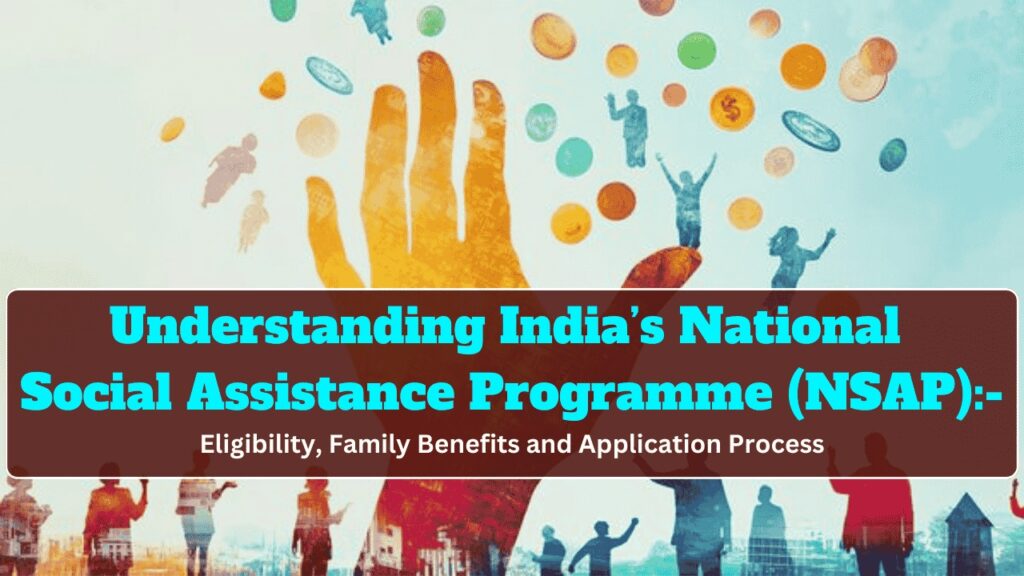
In a country as vast and diverse as India, ensuring the welfare of every citizen is a magnificent task. Among the many challenges faced by the government is providing support to the most vulnerable sections of society- the elderly, widows, persons with disabilities, and families who have lost their supporter. The National Social Assistance Programme (NSAP) was designed precisely to address these concerns, offering a helping hand to those who need it most.
The Birth of NSAP
The National Social Assistance Programme was launched on August 15, 1995, a date that holds special significance as India’s Independence Day. This wasn’t a coincidence the programme represented freedom from adversity for millions of underprivileged citizens.
The roots of NSAP can be traced back to India’s Constitution itself. Articles 41 and 42 of the Constitution recognize that both central and state governments have a responsibility to provide public assistance to citizens facing hardship due to unemployment, old age, sickness, disability, or other circumstances of need. This constitutional backing gives NSAP a solid foundation and highlights its importance in the nation’s social welfare framework.
What Does NSAP Aim to Achieve?
At its core, NSAP is a social security and welfare programme with a clear objective: to provide support to elderly persons, widows, people with disabilities, and families who have lost their primary supporter. Importantly, this assistance is targeted specifically at households living below the poverty line (BPL), ensuring that help reaches those who need it most.
The programme acknowledges that certain groups face unique vulnerabilities in society and may struggle to meet their basic needs without external support. By offering financial assistance and other benefits, NSAP aims to provide a safety net that helps these individuals maintain a basic standard of living and dignity.
The Evolution of NSAP: From Three to Five Schemes
When first introduced in 1995, NSAP consisted of three main components:
- National Old Age Pension Scheme (NOAPS)
- National Family Benefit Scheme (NFBS)
- National Maternity Benefit Scheme (NMBS)
However, as social needs evolved, so did the programme. In 2001, the National Maternity Benefit Scheme was transferred to the Ministry of Health and Family Welfare, reflecting a more focused approach to maternal health issues.
A significant addition came on April 1, 2000, with the launch of the Annapurna Scheme. This initiative was designed to address a crucial gap—providing food security to elderly citizens who, despite being eligible, were not covered under the Old Age Pension Scheme.
Further expansion occurred in February 2009, when two new schemes were introduced:
- Indira Gandhi National Widow Pension Scheme (IGNWPS)
- Indira Gandhi National Disability Pension Scheme (IGNDPS)
Additionally, the original National Old Age Pension Scheme was renamed as the Indira Gandhi National Old Age Pension Scheme (IGNOAPS).
Today, NSAP comprises five robust schemes, each targeting a specific vulnerable group within society.
The Five Pillars of NSAP: Understanding Each Scheme
1. Indira Gandhi National Old Age Pension Scheme (IGNOAPS)
This scheme provides financial support to elderly citizens from BPL households. The eligibility begins at 60 years of age, with beneficiaries receiving Rs.200 per month. Recognizing the increased vulnerability that comes with advanced age, the pension amount increases to Rs.500 per month for those who are 80 years and above.
2. Indira Gandhi National Widow Pension Scheme (IGNWPS)
Widows face unique challenges in Indian society, often struggling with both financial hardship and social marginalization. Under this scheme, widows aged 40 years and above from BPL families receive a monthly pension of Rs.300. Similar to IGNOAPS, this amount increases to Rs.500 per month once the beneficiary reaches 80 years of age.
3. Indira Gandhi National Disability Pension Scheme (IGNDPS)
Persons with severe disabilities (80% disability level) aged 18 years and above from BPL families are eligible for assistance under this scheme. They receive Rs.300 per month, with the amount increasing to Rs.500 per month after reaching 80 years of age. The scheme also specifically includes dwarfism as an eligible category for pension, acknowledging the unique challenges faced by individuals with this condition.
4. National Family Benefit Scheme (NFBS)
This scheme provides a one-time lump sum assistance of Rs.20,000 to bereaved BPL households that have lost their primary supporter. The definition of a “supporter” is inclusive it can be any member of the family whose earnings contribute significantly to the household, including women who are homemakers.
To qualify, the deceased supporter must have been between 18 and 60 years of age at the time of death, and the benefit applies regardless of whether the death was natural or accidental. This financial assistance aims to help families cope with the immediate financial crisis following the loss of income when a supporter passes away.
5. Annapurna Scheme
Food security is a fundamental necessity, especially for elderly citizens who may not have the means to earn a livelihood. The Annapurna Scheme provides 10 kilograms of food grains (either wheat or rice) per month to eligible elderly persons who, despite qualifying for the old age pension scheme, remain uncovered by it for some reason.
Implementation and Funding: A Shared Responsibility
One of the key strengths of NSAP is its collaborative approach to implementation and funding. While the central government provides the framework and a significant portion of the funding, states and union territories also contribute equally as their share.
This shared responsibility ensures better implementation and allows states to adapt the programme to their specific regional contexts while maintaining the core objectives. It exemplifies the cooperative federalism envisioned in India’s constitution, with both central and state governments working together to fulfill their concurrent responsibilities toward social welfare.
The Impact and Significance of NSAP
NSAP has made a meaningful difference in the lives of millions of vulnerable citizens across India. By providing regular financial assistance, it helps beneficiaries meet their basic needs such as food, medicine, and shelter. Beyond the material benefits, the programme also offers recipients a sense of dignity and security.
For elderly persons who may no longer be able to work, widows who have lost their spouses and face social and economic challenges, and persons with disabilities who encounter barriers to employment, these pensions represent not just money but a lifeline that acknowledges their worth and rights as citizens.
Similarly, for families that have lost their supporter, the lump sum assistance under NFBS can help prevent them from falling into deeper poverty during a time of grief and adjustment.
Wrapping Up
The National Social Assistance Programme stands as a testament to India’s commitment to protecting its most vulnerable citizens. Through its five carefully designed schemes, NSAP creates a social safety net that helps ensure no one is left behind simply because of age, disability, widowhood, or the unfortunate loss of a family’s supporter.
As India continues its journey of development, programmes like NSAP remain crucial in ensuring that growth is inclusive and that the constitutional promises of dignity and support for all citizens are fulfilled. By targeting assistance to those below the poverty line, NSAP plays a vital role in reducing extreme hardship and contributing to the broader goal of poverty alleviation in the world’s largest democracy.



